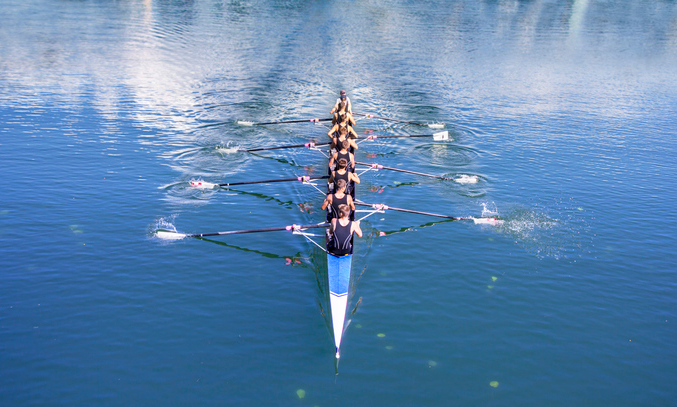Shorter Oars Make for Faster Boats
Next week, rowing teams from Cambridge University will battle for glory in a race down England’s river Cam. Just in time for the event, physicists have a tip for the athletes: To up your speed, shorten your oars.
“If you just want the boat to go the fastest it can, shorter oars are better,” says Michael Benzaquen, who led the new study at École Polytechnique in France. This simple rule is well known to rowing coaches. But Benzaquen and his colleagues developed a mathematical model that could guide the sport in selecting the optimal oar length for a given event or athlete.
The researchers considered a coxless four—a boat with four rowers who each have one oar. They then derived an equation that describes boat speed in terms of the energy that the rower injects into her stroke—the action of moving the oar in, through, and out of the water. The transfer of energy from the rower’s muscles to the motion of the boat depends on various parameters, including the length of the oar from its pivot point to the end of the blade.
The researchers found that longer oars more efficiently transfer energy from the rower to the boat, which is good for endurance races. But shorter oars are preferable for sprints, where rowers aim to zip through the water as fast as possible.
“Endurance [racing] is about being able to row for long periods of time with maximum efficiency,” Benzaquen says, so a long oar is the ideal choice. In sprint races, however, speed trumps an athlete’s energy consumption. “If you spend all your energy in 10 seconds that is not a problem because the race is over quickly.” Shorter oars allow rowers to paddle faster. And even though rowers waste more energy moving the oar in and out of the water, the team’s calculations show that the increased stroke rate more than compensates for the loss.
Other groups have modeled rowing mechanics, but these earlier models assumed a constant velocity of the oar. In Benzaquen’s model, the rowers exert a constant force. This new assumption is reasonable, according to Terry Wilson, the coach of Southampton Amateur Rowing Club in the UK and a former member of British Rowing’s coaching education team. He says that rowers strive to achieve a constant rowing force, although in practice, variations exist.
To check their calculations, the group conducted experiments in a swimming pool using “rowbots”—robotic rowers one tenth the size of humans. As in the model, the rowbots exerted a constant force on the oar. Decreasing the oar length by a third (equivalent to reducing a full-sized oar by around 80 to 100 cm), they found a 20% increase in boat speed, matching the trend predicted in their calculations. “Shorter is better for speed,” says Jean-Philippe Boucher, who coauthored the study and runs a company that designs sensors for monitoring athletic performance. Boucher notes, however, that the oars should only get so short. “Short oars lead to a very high rowing frequency that may not be sustainable by humans.”
Timothée Mouterde, a physicist at École Normale Supérieure in Paris and an amateur rower, believes his sport might benefit from the new analysis. “Coaches know that you can adjust oar length to optimize performance, but here you have the numbers,” he says. (Mouterde’s brother is rowing world champion Augustin Mouterde, whose stroke data appears in the study.) He thinks coaches could use these predictions to fine tune oar length for each rower in a boat, an outcome Boucher is working with athletes and coaches to achieve.
But Wilson is more cautious about the new study’s potential impact. He notes that only elite athletes tinker with oar length. And even then, the adjustments are “minute”—at most a few centimeters—compared to those implemented in the new experiments. For simplicity and fairness, the crews in amateur rowing events like the Cambridge races have identical oars. Playing around with their rigging would likely have very little impact on the boat’s speed, Wilson says. For them, perfecting technique is far more crucial for performance than any minor kit adjustments.
–Katherine Wright
Katherine Wright is a Senior Editor for Physics.





